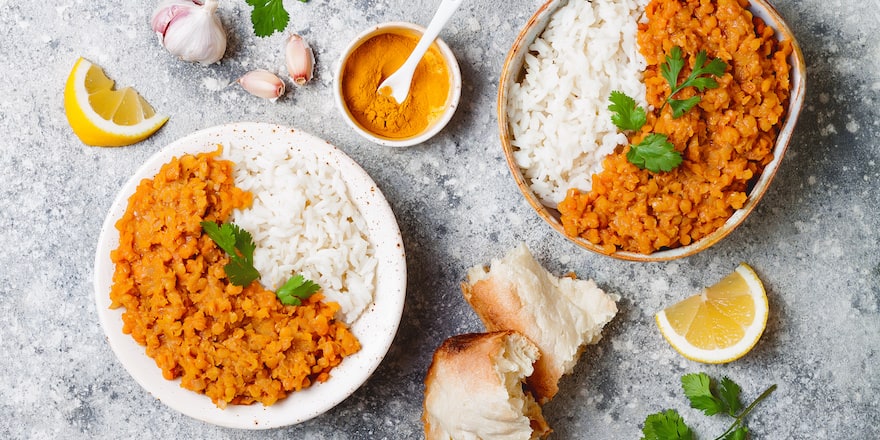Le riz est un aliment de base dans de nombreuses cultures à travers le monde. Il est souvent considéré comme un aliment sain en raison de sa teneur en nutriments essentiels.
However, some people may suffer from constipation when eating rice… Particularly if they consume a large amount of refined white rice.
Let’s look in detail at whether rice contributes to constipation and what alternatives we have available to prevent this problem.
Rice and intestinal discomfort
What is constipation?
First of all, constipation is a common digestive disorder characterized by stools that are difficult to pass and a slowed intestinal transit.
Its causes: poor diet, lack of physical activity, stress, certain medications, or underlying health problems.
Also read | 5 natural laxatives for better transit
White rice and its low fiber content
White rice is rich in starch and can contribute to constipation because of its low fiber content. There are 8 g/100 g of white rice compared to 4 g/100 g for red rice, for example.
Dietary fibers are crucial for good digestive health. Indeed, they help maintain regular bowel movements by increasing the volume and consistency of stools.
It has been processed to remove the fiber-rich outer layer. This makes it less beneficial for digestive health.
So the answer is YES: rice can cause constipation, particularly refined white rice because it severely lacks fiber. Keep in mind, however, that it mainly causes constipation if you eat only that during a meal.
Indeed, if you serve your rice with fiber-rich vegetables, there will be enough fiber in the meal. It’s all about balance!
Rice with fiber: the solution
Furthermore, if you look closely at culinary cultures where white rice plays a major role, it is often served with a dried legume (rich in fiber) in traditional recipes.
I immediately think of Indian lentil dhal, served with rice or of chili con carne with its white rice.

What are the alternatives to classic white rice?
Different varieties of rice
Are you used to eating white rice in quick-cook packets? Know that rice has many surprises if you take a closer look. Indeed, there are plenty of different colors and shapes of rice, for flavorful and colorful dishes.
I can even tell you that there are nearly 110,000 varieties of rice, but I will only talk about a small dozen here.
There are four main varieties and classifications of rice: long-grain rice, medium-grain rice, round rice, and short-grain rice. Among them, there are different forms of commercialization depending on the mechanical processing they have undergone.
Milling involves a degree of polishing of the grain that varies depending on the desired result. The more it is polished, the more whitened it becomes and therefore the fewer fibers it contains (its outer husk being completely removed).
- Brown rice or whole-grain rice: the silica-rich hull is removed by passing it over rollers that strip away the grain’s various husks.
- Polished or white rice : whole-grain rice is further processed to keep only the grain’s endosperm by polishing it more.
- Parboiled rice: starting from the raw grain, it is steamed to drive minerals and vitamins into the rice kernel. This rice has a higher nutritional yield than polished rice but lower than whole-grain rice.
- Pre-cooked rice: starting from parboiled rice, it is cooked again which allows faster cooking at home.
Then, depending on its growing region, there are other types of rice. Thai rice, basmati rice, wild rice, red rice, arborio rice, glutinous rice… And many more.
For example, brown rice, which is high in fiber, can be beneficial for digestive health and help prevent constipation, as this study suggests.
Different flavors but more fiber
Brown rice is less refined than white rice and still contains its outer fiber-rich layer, which makes it a healthier choice for people suffering from constipation.
Brown, whole, red, and wild rice can have a stronger flavor and a firmer texture than white rice. But they can be used in the same way in many recipes.
You can also mix brown rice and white rice to get the benefits of both types of rice.

Some tips to prevent rice-related constipation
In addition to choosing brown or whole grain rice, there are other measures you can take to prevent rice-related constipation:
- Have a balanced diet rich in fruits, vegetables, whole grains and lean proteins.
- Drink enough water to maintain good hydration and promote healthy bowel movements.
- Exercise regularly to support digestion and maintain regular bowel movements.
- Avoid foods that can worsen constipation: dairy products, fried foods, foods high in sugar and fat, alcoholic beverages.
If rice is part of your regular diet, don’t avoid it in case of constipation. However, always pair it with a high-fiber food.
Or choose a type of rice with more fiber than white rice. You’ll add originality to your dishes and your taste buds will thank you.



